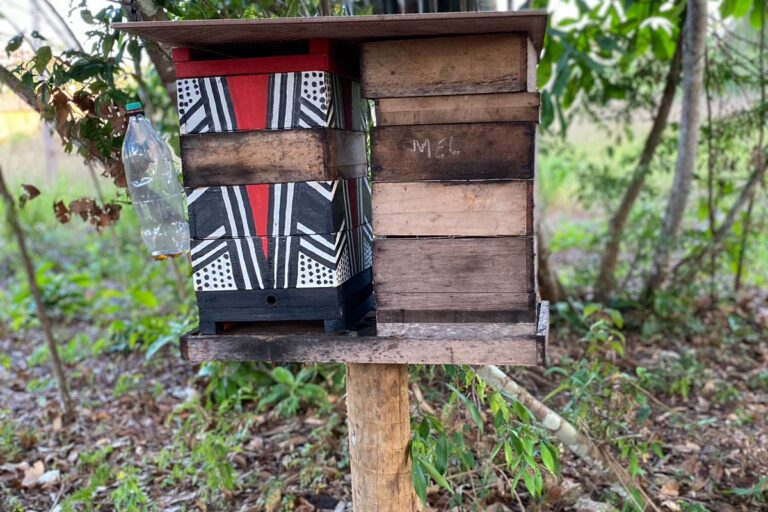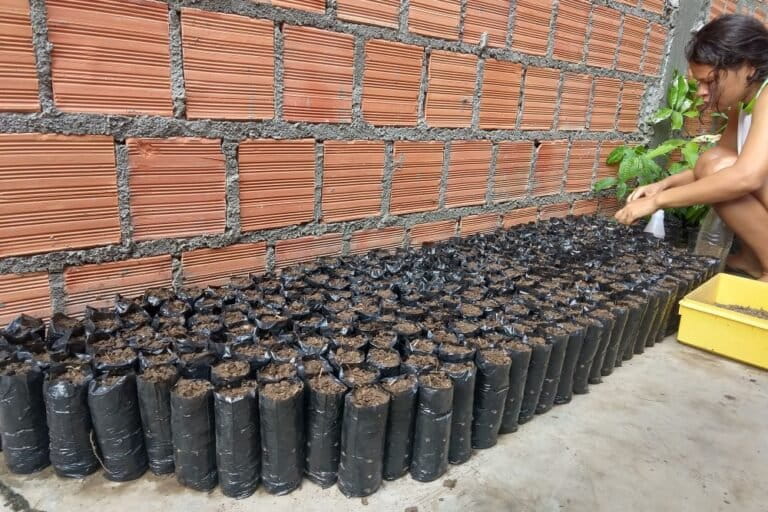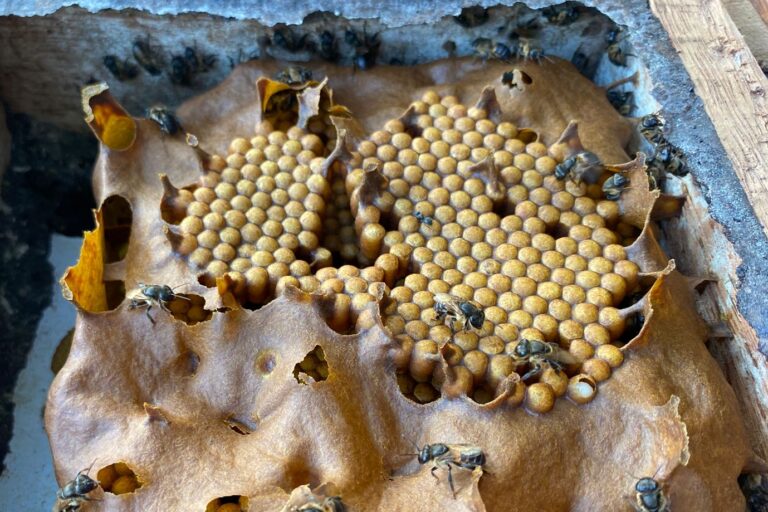- Indigenous territories located in different Brazilian biomes — the Amazon, the Cerrado and the Atlantic Forest — are hosting beekeeping projects aimed at both generating an income and restoring local ecosystems.
- The community projects show how these efforts, associated with agroecological food production, can improve quality of life, especially in the face of climate change impacts.
- The movement began four years ago with a crowdfunding campaign to establish beekeeping in the Amazon, and today includes 53 traditional communities involved in native beekeeping across the country.
Ana Rosa de Lima is a Brazilian materials engineer living in Germany. She had no idea that a 2019 crowdfunding campaign for a beekeeping project in the Indigenous Kayapó village of Mojkàràkô village, in the Brazilian Amazon, would inspire a community-based native beekeeping movement. Four years later, the project that began in Pará state has expanded to all biomes across the country, and is now a network of solutions designed and managed by communities themselves.
Today, the Meli Network Brazil brings together 53 communities — Indigenous, Quilombola (descendants of formerly enslaved Afro-Brazilians), extractivist (communities making a living from the sustainable extraction of natural resources), and campesino — who combine beekeeping with forest recovery to generate an income, reverse environmental degradation caused by encroachers, and strengthen food security through agroforestry.
Ten community projects resulting from this movement were selected by the Pollinating Regeneration program. Supported by the Rockefeller Foundation, the initiative was submitted by the socioenvironmental organization Meli Bees, created by Lima in Germany in 2020 in response to growing demand for incentives for beekeeping after an experience with the Kayapó. Around $50,000 will be allocated directly to selected community efforts.
Besides international fundraising, which enabled them to support microprojects in Brazil, Lima says a growing WhatsApp group worked to spread the seeds for the Meli Network.

“Brazilian community leaders interested in beekeeping joined the movement spontaneously,” she says. “In 2021, we had a year of excellent experiments and concluded that this space for networked reflection is vital.”
From this exchange of ideas and knowledge, Meli Bees created the Pollinizing Regeneration program in 2022 and went after funds for it.
In this collaborative environment, experts in various fields, such as biologists Ana Paula Cipriano and Silvia Lomba, provide technical support to the Meli Network so that communities can turn their ideas into projects that meet the requirements of funding agencies and institutions. “We’ve even received ideas as WhatsApp audio messages, which we transcribed and formatted as project proposals,” Cipriano says.
Both the engineer and the two biologists mentioned in conversations with Mongabay that formatting a project to the standards required by funding institutions is a major challenge for communities in Brazil. That’s why part of the network’s actions involve discussion and training meetings to strengthen skills and protagonism in the locations. “The difference is that we ask the communities what they want and we support them as best we can,” Silvia Lomba says. “We select projects that are like seeds for very promising initiatives in Brazil,” Ana Paula Cipriano says.”
Indigenous Gavião beekeepers in Pará state
Tokurykti Jõkrikatêjê was the first of the 27 villages in the Gavião people’s Mãe Maria Indigenous Territory, in Pará, to invest in beekeeping as an economic activity combined with forest recovery. Today, it has 64 hives, almost twice as many as a year ago, when the joint project with the Meli Network began. Local community leaders say they hope to reach 100 hives soon, and cite good prospects for selling their honey in 2024. Seeking a market advantage that involves Indigenous culture, the village’s women and children paint the beehive boxes with graphics typical of their culture, led by their chief, Tuxati Parkatêjê, an enthusiast of these actions.
Antônio Guajajara, head of the project and community leader, who has been married to Tuxati Parkatêjê for three years, says they harvested 10 liters (2.6 gallons) of high-quality honey during the experimental period, for the consumption of the 38 members of the eight families living in the Indigenous village.

Other villages have also expressed interest in beekeeping, and there are plenty of native bees in the Indigenous territory. According to Antônio Guajajara, these characteristics also tend to help recover areas degraded by cattle ranchers who invaded parts of the Indigenous territory, which was reclaimed by the Gavião in the 1980s. They’ve since been recovering some of these areas by planting Amazon-native tree species, including açaí palms (Euterpe oleracea).
Beekeeping came in handy to increase their açaí grove, with more than 300 trees that will begin producing berries in 2024. “The presence of stingless bees is already making a difference in the trees’ flowering, clearly increased by pollination,” Antônio Guajarara says.
Reclaiming açaí and Brazil nuts
In addition to recovering areas degraded by invaders and generating income for the future, açaí production also feeds Amazonian communities, for whom the fruit is culturally important. Antônio Guajajara says residents of the Mãe Maria Indigenous Territory currently have to buy açaí because the trees on their land have been looted by criminal groups that also steal Brazil nuts (Bertholletia excelsa) and poach the local wildlife.
In Tokurykti Jõkrikatêjê, villagers say they plan to plant 5,000 seedlings within five years. In addition to açaí, there’s cacao (Theobroma cacao), the closely related cupuaçu (Theobroma grandiflorum), and Brazil nuts. According to Antônio Guajajara, the Meli Network’s project is important because it adds to the initiatives that already in Tuxati’s plans. “This is now one of our main projects, and it helps open the eyes of the community,” he says. “It’s something new that benefits the forest and our quality of life.”
However, he notes that “Absence of law enforcement is a serious issue here. We have reported the problems in every way, but answers are slow. We urgently need territorial protection. We are afraid of walking in the forest and running into poachers and looters.” According to Antônio Guajajara, both the Carajás Railway, owned by mining company Vale, and the BR-222 federal road that cuts through the Indigenous land, are conduits that enable criminals from outside to invade deep into the Indigenous territory. So even within their own territory, the Indigenous residents don’t venture near these areas for fear of violence.
Mongabay reported earlier this year on the conflict involving the railway, and numerous other violations alleged by the Gavião are included in a report by Brazil’s National Archives.
From devastated land to one of potential
In Bahia state, in Brazil’s east, farmers had long invaded parts of the Caramuru-Paraguaçu Indigenous Territory. The Indigenous Pataxó Hã-Hã-Hãe people reclaimed these in 1982; after a 30-year court struggle, the Federal Supreme Court sided with them in 2012. The invaders were removed, leaving “a trail of devastated land,” as reported by filmmaker and environmentalist Olinda Tupinambá, president of the Okara Kaapora Association.
Upon returning from her studies in the Bahia state capital, Salvador, in 2015, Olinda Tupinambá says she saw the urgency of focusing on environmental issues in her ancestral territory to try to reverse the existing degradation. “The agroforestry system is the way to recover that devastated land,” she says. She adds that searching for alternatives that are economically compatible with protecting nature and the culture of her people is crucial, since the risk of Indigenous people being enticed by farmers continues to be the main source of pressure.

The joint project with the Meli Network is carried out in an area crossed by the Pardo River, which underwent three years of severe drought between 2016 and 2018. For Olinda Tupinambá, this exacerbated the effects of the climate crisis and highlighted the need for environmental recovery to strengthen local resilience. The efforts became more promising this year, when their forest regeneration work has been more productive, according to reports.
As part of the efforts, they planted some 3,000 seedlings of trees native to the Atlantic Forest biome, such as jenipapo (Genipa americana), pau-ferro (Libidibia ferrea) and jatobá (Hymenaea courbaril), as well as fruit trees such as cajá (Spondias mombin) and banana, and also plants used in traditional Indigenous medicine. “The birds are returning and there are also crabs, rabbits and peccaries,” Olinda Tupinambá says of the effects observed.
The size of the Caramuru-Paraguaçu Indigenous Territory, at more than 54,000 hectares (135,000 acres) and home to around 4,000 residents, but with little in the way of transportation infrastructure, makes it difficult to bring lots of people together. Due to these and other limitations, Olinda Tupinambá says, the project has operated as a pilot experience. “We are in the driest place in the territory. If it works out here, we’ll be showing that it can be done elsewhere,” she says.
She recalls the difficulties they faced at the beginning: “We’d water the plantation with buckets. But within three months, it will be possible to harvest our bananas. Now people see these examples and want to do the same in their areas. That’s what the project is for; it shows that recovering the land always pays.”
Education through beekeeping and a community kitchen
As a result of her interest in the role played by bees in maintaining the ecological balance and food production, Olinda Tupinambá began studying beekeeping. Today, she has 20 beehive boxes that she uses for environmental education activities in the Indigenous territory, where she hosts visiting students from state and municipal schools.
“We need to look more at non-humans and understand that we are part of everything in nature,” she says of the motivation behind the educational outreach. “We want to teach courses and help our communities produce high-quality honey.”
A project to build a community industrial kitchen is also about to be completed. It will be a collaborative space to work on educational activities focused on agroforestry production. “Now is the time to plant, recover and multiply to guarantee self-sufficiency in the future,” Olinda Tupinambá says. “We want to farm without using pesticides, promote courses and consume healthier food.”
In the process of preparing new fields, she highlights the role played by the so-called seed guardians: older residents who contribute to preserving traditional seeds for younger generations, and the future of food security based on ancestral knowledge.

Community organization strengthened in Maranhão
Efforts at community engagement in forest recovery associated with beekeeping have also had an effect on Barreirinha, a village in the Arariboia Indigenous Territory, in the transition area between the Cerrado and Amazon biomes of Maranhão state. Agroecology technician and community leader Jonas Guajajara is a partner of the Meli Network. His project started in March and aims to have 100 beehive boxes this year, or double the current number, opening up a new avenue for generating income from next year’s expected honey production.
For forestry recovery in the village, 1,200 native tree seedlings have already been produced, such as juçara (Euterpe edulis) and bacaba (Oenocarpus bacaba) palms, of which 600 trees have been planted. “Producing juçara seedlings close to the beehives was a brilliant idea we had, since the bees visit the flowers of these palm trees,” Jonas Guajajara says. “We’ve been observing and hearing our grandparents tell of how everything here used to be forest, with streams and species that are disappearing. Hence the effort to recover the forest.”
The work began in five of the 10 regions covered by the vast Arariboia Indigenous Territory; the others lie more than 100 kilometers (60 miles) away, preventing strong community involvement. The idea is to expand the project in the future. By 2024, 360 more seedlings should be produced in six villages, in addition to expanding the beehives through the network’s project. Although there are no buriti (Mauritia flexuosa) and bacuri (Platonia insignis) seeds yet, those of buritirana (Mauritiella armata), murici (Byrsonima crassifoli), bacabi (Oenocarpus mapora), açaí and cupuaçu have been collected and distributed for planting.

A beekeeping enthusiast who has been encouraging the activity in the Arariboia Indigenous Territory, Jonas Guajajara reports that his experimental production yielded 8 l (2.1 gal) of honey last year, at 140 reais ($27.70) per liter, or about $105 per gallon. “It has everything to be successful,” he says.
Interest in beekeeping started in 2020, through training courses and workshops under the state government’s Maranhão Verde Program, which includes an Indigenous component. In that initiative, the Barreirinha villagers began to produce handicrafts, raise stingless bees and small animals, in addition to making agroecological gardens.
That program didn’t run this year. For Jonas Guajajara, though, who started following the group created by the Meli Network in 2022, it made sense to fold the former program into the latter. During the courses, “many relatives had their interest piqued and lost their fear of handling the hives,” he says.
He notes that bee species such as uruçu-amarela (Melipona rufiventris), uruçu-boca-de-renda (Melipona seminigra merrillae) and tiúba (Melipona fasciculata), among others, already abound across the Indigenous territory. “When we find them in a tree, we leave them. If they are in dry trunks, we remove them and take them to the boxes because we know they are vulnerable,” he says. “Our relatives often find bees in fallen trees and tell us so that they can be properly removed and protected.”
Pressure and violence
Over the past two decades, Indigenous people in Maranhão have faced increasing violence from illegal loggers and poachers. According to the Caci Platform, 50 Guajajara were killed between 2003 and 2021, of whom 21 were from the Arariboia Indigenous Territory. The Caci Platform’s database uses information from the “Violence against Indigenous Peoples in Brazil” report published annually by the Indigenist Missionary Council (CIMI), a Catholic Church-affiliated advocacy group.
The environmental situation around the Indigenous territory is worrying. “These are hard times. With part of the forest affected by degradation, river stretches that had not dried out are drying now,” Jonas Guajajara says. While he says there are now positive signs of environmental recovery with the project underway, he adds there are also many challenges still to overcome.
He cites the case of the Zutiua River, the natural border between the Arariboia Indigenous Territory and the urban area of the municipality of Arame. In recent years, farmers have violated this border and expanded their activities into the Indigenous territory. Jonas Guajajara says that if the Indigenous territory didn’t exist, what remains of the forest would have completely disappeared in the municipalities that it straddles. Arariboia covers an area of 413,000 hectares (1.02 million acres) in the border region of the municipalities of Arame, Buriticupu, Amarante do Maranhão, Bom Jesus das Selvas and Santa Luzia.
Banner image: Meliponiculture activities in the Tokurykti Jõkrikatêjê village, on the Mãe Maria Indigenous Territory, of the Gavião Indigenous people (Pará state), involves new generations in educational actions about the importance of native bees in a project by Rede Meli Brasil in partnership with Amazon Conservation Team Brazil (ACT-Brazil). Photo courtesy of Rayda Lima.
CORRECTION (10/19/2023): An earlier version of this article showed the caption of a different banner image. Also, a paragraph from the original Portuguese piece was missing. The post has now been corrected.
This story was reported by Mongabay’s Brazil team and first published here on our Brazil site on Oct. 9, 2023.
